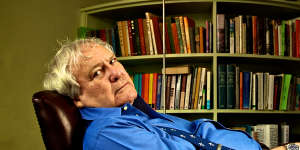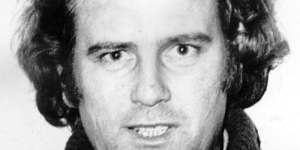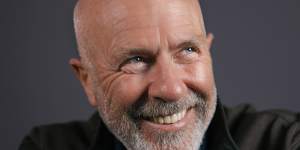Few in Australia have thought as deeply or as long about this situation as the late Frank Moorhouse.
Born into an agricultural manufacturing family,Moorhouse was habituated to thinking in terms of the ways technological infrastructure shapes industry,and how each new media impacts society.

Frank Moorhouse didn’t take copyright infringement lying down.Marco Del Grande
Radio was still nascent when Moorhouse was born in 1938. At age 13,a student newsletter printed his earliest extant short story alongside an essay he co-authored surveying the history of writing and printing:from Ancient Greece to the Gutenberg press and the first newspapers. Television began in 1956 when he became a cadet journalist. That same year,at a conference at Dartmouth College in the US,the term “Artificial Intelligence” was coined to outline a new field of endeavour.
Moorhouse had by then read Norbert Wiener’sThe Human Use of Human Beings (1954),a foundational work in cybernetics:the interaction between human organisms and technology,and the informational feedback loops binding each to each. Like the protagonist of Edgar Allan Poe’sDescent into the Maelstrom,which Moorhouse also read at the time,he studied the pattern of these feedback loops in order to plot an escape.
He is known for the 1970s copyright case,Frank Moorhouse and Angus&Robertson vs University of New South Wales. He sued UNSW for authorising a copyright infringement when a library photocopy machine was used to duplicate a story fromThe Americans,Baby (1972). This was part of a strategy developed by the Australian Society of Authors and the Australian Copyright Council to establish the Copyright Agency Ltd,to collect and distribute fees from the use of copyrighted works.

Frank Moorhouse at the time of his court case against UNSW.
What is not widely known is that Moorhouse had spent the previous decade researching media communications technology. He understood publishing to be as much a manufacturing industry as a cultural industry,with the value of the latter dependent on the conditions created by the former. So he immediately understood the broader implications of the photocopy machine if the cultural feedback loops it introduced were not adequately managed.
In 1967,for example,considering the rise of television and the prospect of computers,Moorhouse argued that “presumably reading and writing will be more a minority activity than it is even now”. He predicted that,instead of reading,“most people will become almost continually hooked up electrically to the rest of the world – both visually and aurally”. By 1968,he referred to “writers as blacksmiths of this century”,a profession sliding toward obsolescence.
This contributed to what he referred to as “the crisis of literature”,and it was under such augurs he published his first book in 1969, Futility and Other Animals. That same year the U.S. Department of Defence launched the Advanced Research Projects Agency Network (ARPANET),networking remote computer terminals:a forerunner of the modern internet.
Like Marshall McLuhan,Moorhouse understood technology to be an extension of the human body. The legal notion,“fair dealing”,allowing portions of copyrighted works to be copied,was conceived when such acts were constrained by human hands writing with pens or pencils. But the photocopy machine – as an extension of the hand – could more easily copy whole books,technology removing earlier constraints.

Richard Flanagan says the Books3 data set was the biggest act of copyright theft in history.Supplied
Moorhouse understood that the law needed to be constantly updated to accompany each new advance in technology. For this reason,from the 1970s,he participated in various organisations and campaigns,advocating for authors’ rights and the need to take seriously the negative impacts introduced by each new technology.
If photocopy machines could duplicate whole books,by the new century digital technology could swallow entire libraries. “Google and other search engines have begun scanning existing hard-copy libraries which include books which are in copyright,” he warned in 2005. “Google is proceeding with the scheme despite the legal actions.“
In 2021,a year before Moorhouse died,the National Library of New Zealand donated about 400,000 books to the Internet Archive to digitise,regardless of their copyright status. No one noticed that among the Moorhouse books was a 1972 edition ofThe Americans,Baby,the book at the heart of his landmark copyright case that had created the protections international tech companies were now wilfully shredding.
Moorhouse did not live to see that some of his books were also included in the more recent Book3 dataset. Richard Flanagan,another Australian author whose books were included,called this “the biggest act of copyright theft in history”.
One of the Moorhouse books included was his final work,The Drover’s Wife,a study of the classic Australian author,Henry Lawson. In 1899,Lawson argued in The Bulletin that publishing practices conspired against writers earning a just living from their literary efforts. The main problem in colonial Australia was “clipping”,when material from one publication was “clipped” and reprinted in another publication without prior consent or payment. Little has changed except the technical capacity to “clip” entire books and libraries at an industrial scale.
The first volume of my cultural history,Frank Moorhouse:Strange Paths,ends in 1974,with the high court sitting in judgement on his copyright case. In reconstructing the long,slow process by which Moorhouse developed as a writer,it became clear that there are no shortcuts in making literature. There are no efficiencies to be gained by outsourcing our imagination to generative AI.
I envisage literary biography taking a greater role in the future,as a record and account of the all-too-human struggles and triumphs that go into creating works of literature:a testimony to the value of literary effort,and a culture that,following Moorhouse’s example,works alongside technology when we need to,overcome it where we can,and resist it when we must.
Frank Moorhouse:Strange Paths is published by Knopf. Matthew Lamb writes at publicthings.substack.com
The Booklist is a weekly newsletter for book lovers from books editor Jason Steger..
